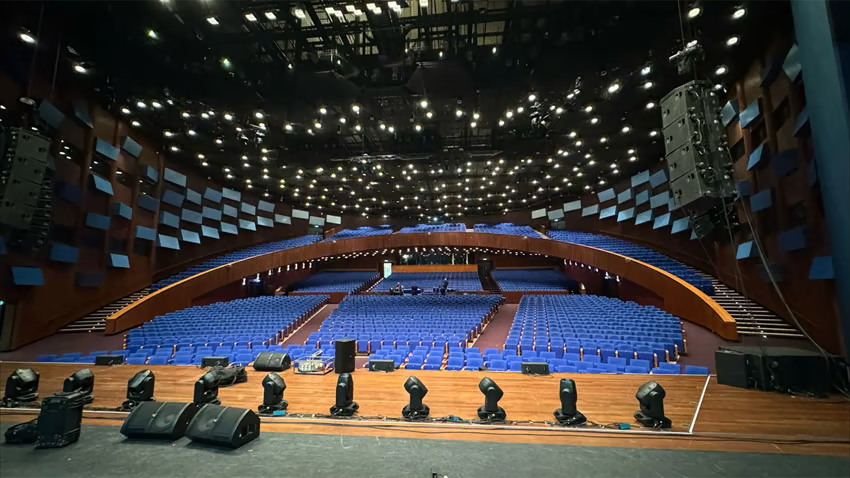Los Angeles, CA — The fundamental requirement for a world-class production sound mixer is simple: knowing and understanding sound. Yet, for over two decades, Bruce Beacom, an Emmy-nominated engineer responsible for capturing critical audio on global phenomena like The Amazing Race and Top Chef, has navigated the world of location sound while battling a devastating condition that rendered him 95% hearing impaired. Despite the challenges, Beacom has continued to amass countless high profile credits through a combination of radical adaptation and the use of uncompromising digital wireless tools such as Lectrosonics UCR411a and IFBR1a receivers and SMQV and UM400a transmitters, which he credits as indispensable partners in his professional success.
Beacom, who cut his teeth in post-production in New York City beginning in 1995, made the transition to location sound around 2001, “seeking the outdoors after years locked inside a recording studio.” His credits quickly grew, including 16 seasons on the previously mentioned Top Chef and fifteen consecutive seasons of CBS’s Emmy Award-winning The Amazing Race, for which he received three honorary Emmy certificates. He has also worked on Big Brother, The Bachelor franchise, Netflix’s Jeffrey Epstein: Filthy Rich, and regularly works with Entertainment Tonight. In addition, Beacom was Emmy-nominated for Sound Mixing for his work on HBO's Project Greenlight (Season 4), produced by Matt Damon and Ben Affleck.
Beacom started using Lectrosonics in 2003 with the UCR211 on the Fox show Paradise Hotel and is still a “proud legacy guy to this day.” His comprehensive kit consists mainly of equipment he purchased years ago including SRb, M2R, UCR411a, and R1a receivers and SMQV and UM400A transmitters. He also maintains gear like the UM200 transmitter and the UCR211 receiver in his arsenal for overseas jobs, where he can continue to use them to access blocks no longer available in the US due to regulation changes in 2018.
“Lectrosonics products are so well-made and reliable. I take care of my equipment, but Lectrosonics also takes care of me. I buy it, read the manual, put it to use and I’ve never had a problem. It’s impressive that I am still using gear I bought over a decade ago,” he shares. “Their rugged build quality is so important, but so is their exceptional range. Both were the reasons why I used the UM400a and UCR411a for years on Amazing Race.”
Bruce’s crisis began in his late twenties with a “horrible and deafening ringing—an internal siren that was incapacitating.” After years of searching and misdiagnoses, he was finally diagnosed with otosclerosis, a rare genetic disorder where bone overgrowth prevents sound transmission in the middle ear. By age 33, his hearing was almost completely gone.
To explain his condition, Beacom compares the ear to a professional PA system, “The eardrum is the microphone and the middle ear bones are the crucial XLR cable connecting the signal to the cochlea, the amplifier,” He explains “Otosclerosis is like taking wire cutters to that XLR cable, disrupting the conductive path”
Instead of yielding, Beacom was forced to adapt in ways that went beyond the skill set of a traditional sound mixer and he adopted an approach that bypassed his damaged anatomy entirely: “When I was almost completely deaf, I set the headphones to mono and turned them up so they would vibrate against my skull and I could feel it.”
He also learned to rely on the visible world of audio data, “I developed a visual sense for sound, specifically by focusing on VU meters... always paying attention to make sure that the meters are bouncing, not erratically, over modulating, or too low, but balanced and healthy. I mixed a few years purely that way and surprisingly this made me a better engineer, even after regaining my hearing, because I take into account more dimensions of the sounds I’m capturing, it’s almost like having a sixth sense.”
To regain his ability to hear, he underwent six total ear surgeries—four stapedectomies between 2004 and 2007, and two more in 2021 and 2022—to install titanium prosthetic bones in both ears, restoring his hearing to 80% with the use of custom Oticon hearing aids.
His reliance on Lectrosonics gear has been key to maintaining his career and provided the foundation necessary for him to perform his job: “Lectrosonics has been with me throughout it all and I wouldn’t be able to do my job as a sound engineer without it. Even when I was struggling through the worst stages of my hearing loss, I never doubted I would capture what I needed with Lectrosonics,” he confides. “And that carries through to today. I know when I’m miking somebody up with Lectro, I’m going to capture great content. When you walk onto a set with confidence like that, it affects the way you collaborate with other people, and their confidence in you as well. I’m still working, I’m lucky to be doing it, and I’m thankful every day.”
Bruce Beacom’s fight to save his hearing underscores that early diagnosis and vigilance are critical. Audio professionals can learn about the latest research on hearing and long-term ear health and testing by visiting The House Institute.
About Lectrosonics
Well-respected within the film, broadcast, and theatre technical communities since 1971, Lectrosonics wireless microphone systems and audio processing products are used daily in mission-critical applications by audio engineers familiar with the company’s dedication to quality, customer service, and innovation. Lectrosonics received an Academy Scientific and Technical Award for its Digital Hybrid Wireless® technology and is a US manufacturer based in Rio Rancho, New Mexico. Visit the company online at www.lectrosonics.com.
Support USITT
For many 501(c)3 nonprofit organizations, USITT included, donations are a lifeline. We are able to continue to expand our online offerings to our Members and to our industry thanks to Membership dollars and the generosity of our donors.

.avif)




